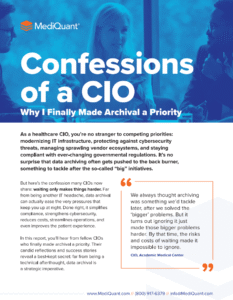Leveraging Healthcare Data Archiving for Competitive Advantage: 5 Post M&A Considerations for Healthcare Organizations
Written By: Cindy Adkins (CRCR, CPC, CSPPM), Director, Revenue Cycle Solutions, MediQuant
If you’re a digital health leader for a large hospital or health system, chances are you’re either anticipating or have already been impacted by mergers and acquisitions (M&A). In Q1 of 2024, hospital M&A activity surged to $12 billion, the industry’s highest level since 2020, according to research firm Kaufman Hall.
For those of you that have passed the M&A finish line, congratulations! You’ve made it through the legal transaction. Now there’s another challenge to complete: integrating data across hundreds or even thousands of disparate or redundant clinical, financial, and ERP systems.
What’s at stake? How you manage your legacy data post-M&A could either save or cost you millions of dollars in licensing fees. It could also reduce or increase your vulnerability to cyber threats.
There’s little room for error when the affordability, efficiency, and security of your future IT infrastructure are on the line. How then, can you be sure you’re making the right call about the way to manage your legacy health data?
As someone who’s led hundreds of archival projects over the past 20 years, I’ve seen the best-and worst-case (and everything in between) scenarios involving post-merger legacy health data management.
I’ve learned there are 5 things that digital health leaders who successfully manage their organization’s legacy health data do or think about after M&As.
1. Decide the Fate of Legacy Systems
Post-merger or acquisition, health systems typically consolidate to a single internal accounts receivable platform. But what happens to the legacy systems? You have several options:
- Keep systems running: Costly, but avoids the risk of data loss, often resulting in millions spent on maintaining outdated technology resulting in an increased cyber-attack surface.
- Migrate or Convert: Poses risks like data corruption or loss and expenses but integrates data into the current system, ensuring operational continuity.
- Implement legacy archiving: Strikes the best balance by reducing licensing fees and maintenance costs while retaining access to historical data.
- Using offline storage: Less costly but may complicate data retrieval due to lack of easy access and potential data retrieval delays.
- Destroying the data: Risky and may lead to compliance issues. Typically, healthcare data storage requirements guidelines require keeping records for as much to 30 years. Future data-driven innovation needs and insights could be compromised.
Dr. Pults recommends starting application rationalization early in the M&A process. She says, “The insights from your inventory are helpful to create a realistic EMR/EHR archiving budget. It can also inform your transition services agreement, ensuring you’ve set data transfer deadlines that match the scope and complexity of the IT environment.
2. Conduct a Comprehensive Data Inventory
Understanding your data—whether it’s discrete or non-discrete—helps decide what to archive and what to keep active, streamlining your legacy data management.
Typically part of an Application Rationalization process, an inventory tool should be used to identify discrete and non-discrete data across your organization’s applications and systems.
It’s important to not only focus on “high value” systems containing patient record and billing, but also include ancillary or disparate ones such as SQL, MUMPS, and Oracle databases. A thoughtful approach to performing an inventory will help your organization:
- Ensure comprehensive understanding of all systems: This includes knowing the details of applications within each system such as vendor, application version, and more.
- Evaluate data quality and relevance: You have to assess the completeness and accuracy of data to reduce the risks of redundancy and inaccuracies.
- Determine which applications are essential: First, you’ll need to define what’s considered coessential vs. non-essential. Essential data sets typically are ones are vital to maintaining continuity of care, or compliance, or systems containing financial information for billing.

3. Choose the Right Solution for Active Healthcare Data Archiving
A healthcare active archival gives users the ability to meaningfully interact with discrete data to perform valuable functions like searching or analyzing patient information. It consolidates multiple data sources into a single repository, enhancing operations.
Unlike a static archive where users are limited to “read only access” to data in a flat PDF, a healthcare active archive offers users interactive and flexible means of healthcare legacy data management. With an active archive, users can record corrections or release patient information, perform specific actions like changing demographics, send follow-up bills, edit, payments and more.
An effective healthcare active archive should have the following features.
- Single sign-on: Simplifies access across systems, allowing hospital staff to easily look up details within an archived medical record for clinical care and billing.
- Uniform data loading: Ensures consistent data integration, reducing errors and improving reliability.
- Cross-system patient information lookup: Enhances data accessibility, crucial for clinicians who need immediate access to patient histories.
- Data governance and compliance with data retention requirements: Ensure compliance with health care data retention requirements and requirements for creating, maintaining, and destroying patient records specified by local, state, or federal laws.
- Effective data management: Enables your organization to efficiently fulfill reporting requirements, like Release of Information (ROI) also requests so ensures data is properly formatted for analysis to drive data-driven insights, supporting future innovation.
4. Align with the Needs of Revenue Cycle Management (RCM) Staff
- Ensure their needs are met for maintaining accurate financial records.
- Identify potential issues such as discrepancies in billing data.
- Address issues before they escalate to keep your archival project on time and on budget.
5. Ensure Robust Data Retrieval and Reporting Capabilities
- The ability to generate transaction reports, which helps track financial performance.
- The capability to upload master files, ensuring comprehensive data inclusion.
- Support for batch or manual postings, offering flexibility in handling data entries.
- Options to post payments and adjustments manually or electronically, ensuring accuracy in financial records.
- The ability to manage demographic updates and audit requests efficiently, optimizing administrative processes.
- Interfaces for seamless integration, ensuring smooth operation across systems.
- The ability to generate customizable reports for compliance and strategic decisions to help you meet healthcare data compliance and healthcare storage requirements.
Active Healthcare Data Archiving Supports Seamless Post M&A Integration
Anticipating or Undergoing an M&A?
Watch this short video from Becker’s Health IT + Revenue
Cycle Management Virtual Forum. Visit us online to learn more.
More Thought Leadership
Protecting the Legal Medical Record: A Critical Risk in Government Health IT Modernization
Kel Pults | Chief Clinical Officer & VP, Government Strategy | November 24, 2025As healthcare IT continues to evolve, the dual forces of interoperability and artificial intelligence (AI) are driving innovation across the industry. Yet, amidst these advancements,...
Protecting Revenue Integrity After System Conversion: The Role of Healthcare Data Archiving
Cindy Adkins CPC, CRCR, CSPPM, Director of Revenue Cycle Solutions, MediQuant | November 17, 2025 | BlogProtecting Revenue Integrity After System Conversion: The Role of Healthcare Data ArchivingFor many health systems, completing a major technology conversion –...
ERP Data Migration Best Practices for Health Systems
As healthcare organizations modernize their infrastructure, ERP data migration becomes a critical step in moving from legacy systems to next-generation platforms. Transferring ERP data involves significant complexity and risk, from compliance concerns and system...
Contact Us Today







